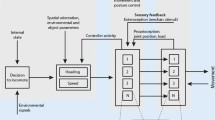Abstract
Insects generate walking patterns which depend upon external conditions. For example, when an insect is exposed to an additional load parallel to the direction in which it is walking, the walking pattern changes according to the magnitude of the load. Furthermore, even after some of its legs have been amputated, an insect will produce walking patterns with its remaining legs. These adaptations in insect walking could not previously be explained by a mathematical model, since the mathematical models were based upon the hypothesis that the relationship between walking velocity and walking patterns is fixed under all conditions. We have produced a mathematical model which describes self-organizing insect walking patterns in real-time by using feedback information regarding muscle load (Kimura et al. 1993). As part of this model, we introduced a new rule to coordinate leg movement, in which the information is circulated to optimize the efficiency of the energy transduction of each effector organ. We describe this mechanism as ‘the least dissatisfaction for the greatest number of elements’. In this paper, we introduce the following aspects of this model, which reflect adaptability to changing circumstances: (1) after one leg is exposed to a transient perturbation, the walking pattern recovers swiftly; (2) when the external load parallel to the walking direction is continuously increased or decreased, the pattern transition point is shifted according to the magnitude of the load increment or decrement. This model generates a walking pattern which optimizes energy consumption at a given walking velocity even under these conditions; and (3) when some of the legs are amputated, the model generates walking patterns which are consistent with experimental results. We also discuss the ability of a hierarchical self-organizing model to describe a swift and flexible information processing system.
Similar content being viewed by others
References
Bässler U (1986) Functional principles of pattern generation for walking movements of stick insect forelegs: the role of the femoral chordotonal organ afferences. J Exp Biol 136:125–147
Bässler U (1987) Timing and shaping influences on the motor output for walking in stick insects. Biol Cybern 55:397–401
Bässler U, Wegner U (1983) Motor output of the denervated thoracic ventral nerve cord in the stick insect Carausius morosus. J Exp Biol 105:127–145
Beer RD, Chiel HJ, Quinn RD, Espenschied KS, Larsson P (1992) A distributed neural network for hexapod robot locomotion. Neural Comput 4:356–365
Brooks RA (1989) A robot that walks; emergent behaviors from a carefully evolved network. Neural Comput 1:253–262
Chiel HJ, Beer RD, Quinn RD, Espenschied KS (1992) Robustness of a distributed neural network controller for locomotion in a hexapod robot. IEEE Trans Robotics and Automation RA- 8:293–303
Cruse H (1979) A new model describing the coordination patterns of the legs of a walking stick insect. Biol Cybern 32:107–113
Cruse H (1980a) A quantitive model of the walking incorporating central and peripheral influences. I. The control of the individual leg. Biol Cybern 37:131–136
Cruse H (1980b) A quantitive model of the walking incorporating central and peripheral influences. II. The connections between the different legs. Biol Cybern 37:137–144
Dean J (1989) Leg coordination in the stick insect Carausius morosus. Effects of cutting thoracic connectives. J Exp Biol 145:103–131
Delcomyn F (1971) The locomotion of the cockroach Periplaneta americana. J Exp Biol 54:443–452
Foth E, Graham D (1983a) Influence of loading parallel to the body axis on the walking coordination of an insect. I. Ipsilateral effects. Biol Cybern 47:17–23
Foth E, Graham D (1983b) Influence of loading parallel to the body axis on the walking coordination of an insect. II. Contralateral effects. Biol Cybern 48:149–157
Graham D (1972) An analysis of walking in the first instar and adjult stick insect Carausius morosus. J Comp Physiol 81:23–52
Graham D (1977) Simulation of a model for the coordination of leg movement in free walking insects. Biol Cybern 26:187–198
Graham D, Cruse H (1981) Coordinated walking of stick insects on mercury surface. Exp Biol 92:229–241
Hoyt DF, Taylor CR (1981) Gait and the energetics of locomotion in horses. Nature 292:239–240
Hughes GM (1952) The coordination of insect movements. I. The walking movements of insects. J Exp Biol 29:267–283
Kimura S, Yano M, Shimizu H (1993) A self-organizing model of walking patterns of insect. Biol Cybern 69:183–193
Land MF (1972) Stepping movements made by jumping spiders during turns mediated by the lateral eyes. J Exp Biol 57:15–40
Laurent G, Burrows M (1988) A population of ascending intersegmental interneurones in the locust with mechanosensory inputs from a hind leg. J Comp Physiol 275:1–12
Laurent G, Burrows M (1989a) Distribution of intersegmental inputs to nonspiking local interneurons and motor neurons in the locust. J Neurosci 9:3019–3029
Laurent G, Burrows M (1989b) Distribution of intersegmental inputs to nonspiking local interneurons and motor neurons in the locust. J Neurosci 9:3030–3039
Nothof U, Bässler U (1990) The network producing ‘active reaction’ of stick insects in a functional element of different pattern generating systems. Biol Cybern 62:453–462
Pearson KG (1976) The control of walking. Sci Am 235:72–86
Pearson KG, Iles JF (1970) Discharge patterns of coxal levator and depressor motoneurones of the cockroach Periplaneta americana. J Exp Biol 52:139–165
Pearson KG, Fourtner CR, Wong RK (1973) In: Stein RB, Pearson KG, Smith RS, Redford JB (ed) Control of posture and locomotion. Plenum Press, New York, pp 495–514
Weiland G, Hoyle G (1987) Sensory feedback during active movements of stick insects. J Exp Biol 133:137–156
Wendler G (1964) Laufen und Stehen der Stabheuschrecke Carausius morosus: Sinnesborstenfelder in den Beingelenken als Glieder von Regelkreisen. Z Vgl Physiol 48:198–250
Wendler G (1978) Erzeugung und Kontrolle koordinierter Bewegungen bei Tieren —Beispiele an Insekten. In: Hauske G, Butenandt E (ed) Kybernetik 1977. Oldenbourg, Munich, pp 11–34
Wilson DM (1966) Insect walking. Ann Rev Entomol 11:103–122
Author information
Authors and Affiliations
Rights and permissions
About this article
Cite this article
Kimura, S., Yano, M. & Shimizu, H. A self-organizing model of walking patterns of insects. Biol. Cybern. 70, 505–512 (1994). https://doi.org/10.1007/BF00198803
Received:
Accepted:
Issue Date:
DOI: https://doi.org/10.1007/BF00198803




